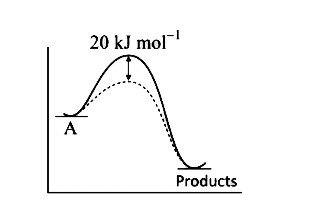A→ Product, [A]0=2M. After 10min reaction is 10% completed. If d[A]dt=k[A], then t1/2 is approximately
0.693 min
69.3 min
66.0 min
0.0693 min
The correct Answer is:C
t1/2t0.1=0.693R×k2.303×0.045
or t1/2≅66.0min
Topper's Solved these Questions
- RATES OF REACTIONS AND CHEMICAL KINETICSBOOK - DINESH PUBLICATIONCHAPTER - RATES OF REACTIONS AND CHEMICAL KINETICSEXERCISE - Revision Question
168 Videos
- RATES OF REACTIONS AND CHEMICAL KINETICSBOOK - DINESH PUBLICATIONCHAPTER - RATES OF REACTIONS AND CHEMICAL KINETICSEXERCISE - Selected Straight
49 Videos
- PHYSICAL AND CHEMICAL EQUILIBRIABOOK - DINESH PUBLICATIONCHAPTER - PHYSICAL AND CHEMICAL EQUILIBRIAEXERCISE - ULTIMATE PREPARATORY PACKAGE
13 Videos
- REDOX REACTIONSBOOK - DINESH PUBLICATIONCHAPTER - REDOX REACTIONSEXERCISE - Reasoning Type Questions
4 Videos
Similar Questions
Consider the reaction : A→B+C. Initial concentration of A is 1 M. 20 minutes time is required for completion of 20% reaction. If d[B]dt=k[A], then calculate half life (t1/2) of reaction.
View SolutionFor the following reaction,
A500K−−→ Products
A400K/catalyst−−−−−−−−→ Product
If (−d[A]dt)500K=−(d[A]dt)400K
no catalyst in presence of catalyst Then Ea is approximately :

View Solution
Knowledge Check
A→ Product, [A]0=2M. After 10 min reaction is 10% completed. If d[A]dt=k[A], then t1/2 is approximately
A0.693 minB69.3 minC66.0 minD0.0693 minA reaction of first-order completed 90% in 90 minutes, hence, it is completed 50% in approximately :
A50 minB54 minC27 minD62 minA first order reaction is 10% complete in 20 min. the time taken for 19% completion is :
A30 minB40 minC50 minD38 min
A first order reaction is 20% completed in 10min, (70+h) min it take to complete 80% .What is h? (approximately) (log1.25=0.0969 )
View SolutionFor zero order reaction :
A+2B→Product
If initial concentration of A is 2a and rate law.
−dBdt=K[A]o[B]o
then t1/2 of A will be
View SolutionA first orde reaction is 75% completed after 32min. When was 50% of the reaction completed?
View SolutionFor a reation: A→ Product,
rate law is −d[A]dt=K[A]0.
The concentration of A left after time t when t=1K is:
View SolutionIn the reaction 3A→2B, rate of reaction +d[B]dt is equal to :
View Solution
